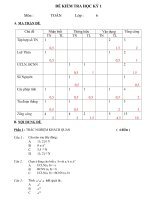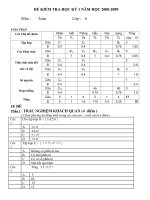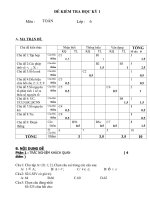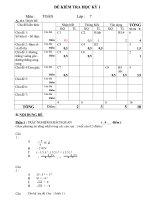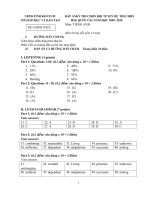click vào chữ read more để xem toàn bài và có thể download 1 bộ bài học internet marketing tiếng anh tuần 1 tuần 2 tuần 3 tuần 4 tuần 5 tuần 6 tuần 7 tuần 8 tuần 9 tuần 10 tuần 11 tuần 12 tuầ
Bạn đang xem bản rút gọn của tài liệu. Xem và tải ngay bản đầy đủ của tài liệu tại đây (82.31 KB, 18 trang )
<span class='text_page_counter'>(1)</span><div class='page_container' data-page=1>
Usability of the Internet
</div>
<span class='text_page_counter'>(2)</span><div class='page_container' data-page=2>
Objectives
• Defining the Internet
• Internet tools to access information
• The world wide web
• Intranets versus extranets
• Web site hosting
• Internet Retailing
</div>
<span class='text_page_counter'>(3)</span><div class='page_container' data-page=3>
What is the Internet
• Started in 1960s as the ARPAnet research and
defense network in the USA
• Infrastructure: the hardware, software, databases
and telecommunications
• Services: Software-based services such as search
engines, digital money and security systems
</div>
<span class='text_page_counter'>(4)</span><div class='page_container' data-page=4>
The Internet
• As compared with other alternative technologies the
Internet offers:
– international connectivity and access to international markets,
– a strong North American market, which in many senses could be
viewed as the domestic market for most Internet retailers,
– full multimedia display facilities, which allow retailers to display
and demonstrate their products, possibly with the use of audio and
video (in some cases, as in the sale of music, for example, such
facilities allow the customer to sample the product),
– more sophisticated electronic ordering and payment facilities,
– much larger installed base of workstations, thus giving access to
</div>
<span class='text_page_counter'>(5)</span><div class='page_container' data-page=5>
The Internet refers to the physical network
that links computers across the globe. It
consists of the infrastructure of network
servers and communication links between
them that are used to hold and transport the
vast amount of information on the Internet.
The Internet enables transfer of messages and
</div>
<span class='text_page_counter'>(6)</span><div class='page_container' data-page=6>
The passing of data packets around the
Internet occurs via the TCP/IP protocol, or
transfer Control Protocol/Internet Protocol.
For a PC to be able to receive web pages or
</div>
<span class='text_page_counter'>(7)</span><div class='page_container' data-page=7>
Application of Different tools
<i>Internet tool</i> <i>Summary</i>
Electronic mail or e-mail Sending messages or documents, such as news about a new product or sales
promotion between individuals. A primitive form of push channel.
Internet relay chat (IRC) This is a synchronous communications communications tool that allows a text-based
chat between different users who logged on at the same time. Of limited use for
marketing purpose.
Usenet newsgroups An electronic bulletin board used to discuss a particular topic such as a sport, hobby
or business area. Traditionally accessed by special news reader software, these can
now be accessed via a web browser from Deja News (www.dejanews.com)
FTP file transfer The File Transfer Protocol is used as a standard for moving files across the Internet.
Used to download files and update HTML (Hypertext Markup Language) files on
web pages.
Gophers, Archie and WAIS These tools were important before the advent of the World Wide Web for storing and
searching documents on the Internet. They have been superseded by the web.
Telnet This allows remote access to computer systems. For example a retailer could check to
see whether an item was in stock in a warehouse using telnet.
Push channel Information is broadcast over the Internet or an intranet and received using a web
browser or special program for which a subscription to this channel has been set up.
World Wide Web www is widely used for publishing information and running business applications
</div>
<span class='text_page_counter'>(8)</span><div class='page_container' data-page=8>
Web Browsers and servers
• Enable web addresses to be entered, to set up communications
links with sites and to download HTML pages.
• Display web pages and interactive forms,and to run programs
such as plug-ins and Java
• Enable navigation between sites by using forward and
backward options and hyperlinks
• Record on the hard disk a copy of sites visited and the pages
downloaded (caching), to enable quicker downloading and
referencing in future.
• Allow useful sites to be bookmarked for later use
</div>
<span class='text_page_counter'>(9)</span><div class='page_container' data-page=9>
The Benefits of Web Browsers
• Easy to use since navigation between documents
is enabled by clicking on hyperlinks or images
• They can provide a graphical environment
supporting multimedia, which is popular with
users and gives a visual medium for advertising
</div>
<span class='text_page_counter'>(10)</span><div class='page_container' data-page=10>
How Are Web Pages Displayed
• User requests web page by clicking on a hyperlink or
typing in URL (Universal Resource Locator) into web
browser.
• Request is sent across Internet from web browser to web
server using http (hypertext transfer protocol)
• Information is returned using http from web server to web
browser
</div>
<span class='text_page_counter'>(11)</span><div class='page_container' data-page=11>
Main Elements of a Web Page
• Text information (HTML and XML)
• Static graphical images (GIF and JPEG files)
• Animated graphical images (GIFs and plug-ins)
• Interactive form elements (CGI – Common
</div>
<span class='text_page_counter'>(12)</span><div class='page_container' data-page=12>
Intranets and Extranets
Intranet
Extranet
The Internet
The
World
Suppliers
Company
only <sub>Suppliers</sub>
</div>
<span class='text_page_counter'>(13)</span><div class='page_container' data-page=13>
Connecting to the Internet as a User
• Hardware –
– Computer to run the web browser and software required
– Modem, gateway server
– Digital or analogue connection
• Software
– Web browser (Netscape, explorer)
– Connectivity software - TCP/IP standard
</div>
<span class='text_page_counter'>(14)</span><div class='page_container' data-page=14>
Hosting a Web Site
• Register domain name
• Find ISP to connect to the Internet or host web server
• Find an appropriate server computer to enable the
following standards:
– http:// serving web pages
– ftp:// remote file access
– SMTP Internet e-mail
• Develop graphic and HTML content
</div>
<span class='text_page_counter'>(15)</span><div class='page_container' data-page=15>
Development stages
• Maglitta (1994) identifies the following initial development
stages associated with opening for business on the Internet:
– set the information-sharing policy,
– restructure database,
– develop applications,
– integrate external and internal databases,
– test links with customers,
– negotiate the role of sales,
</div>
<span class='text_page_counter'>(16)</span><div class='page_container' data-page=16>
Advantages of Internet Retailing
• Small businesses can extend their reach.
• It eliminates prohibitive costs of entry to many industries.
• Hardware and software advances permit improved interfaces and
functionality.
• Online information is current.
• Interaction with customer representatives and immediate ordering are
possible.
• It eliminates costs associated with the store, salespeople and possibly
some warehousing costs.
• As compared with conventional catalogues there are no printing and
mailing costs, and the information can be rapidly changed and updated.
• Much more extensive advertising coverage can be achieved for a
</div>
<span class='text_page_counter'>(17)</span><div class='page_container' data-page=17>
Internet Marketing Mix
<i>• Promotion - includes advertising and creating product </i>
awareness. Information must be presented in a way that will hold
the users' interests.
<i>• One-to-one contact - unlike a real store, the Net does not offer </i>
marketers opportunities of synchronous one-to-one contact with
customers. The Net does, however, allow for asynchronous
contact via e-mail, and this can be used to develop a relationship
with a customer.
</div>
<span class='text_page_counter'>(18)</span><div class='page_container' data-page=18>
Internet Marketing Mix Con’t
<i>• Transaction - payment for goods is typically made </i>
in cash, or by credit card. Digital forms of
currency are also being developed by companies
like DigiCash, CyberCash and NetCash.
<i>• Fulfillment - involves the delivery of goods. </i>
Delivery online is restricted to digital products
such as electronic books and software. Fulfillment
includes not only shipping, but also effective
</div>
<!--links-->
Đề thi Toán HK1 và đáp án lớp 6 (Đề 5)
- 3
- 1
- 27
